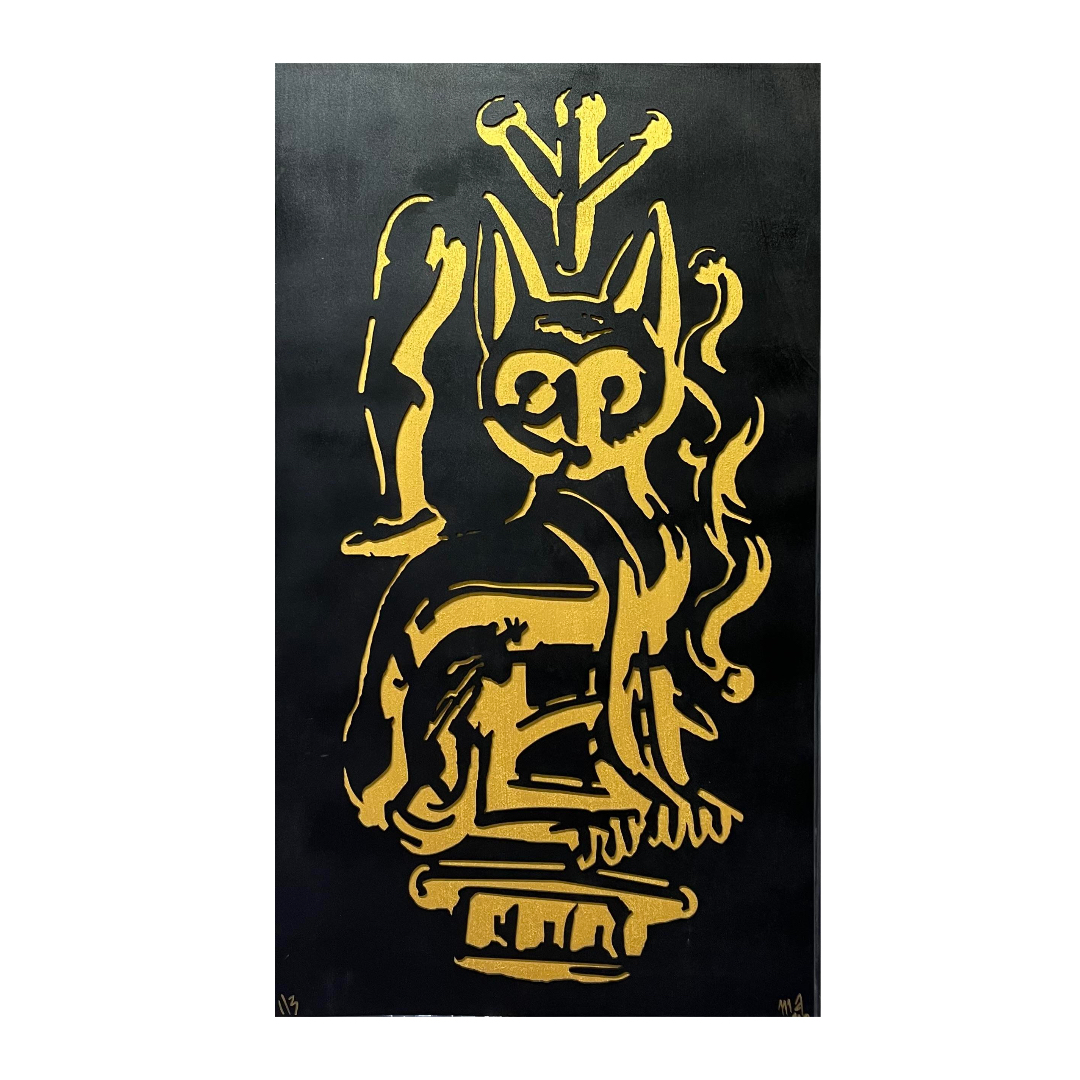Αν ο «Φύλακας του Ανέμου» ήταν ο φρουρός του ανέφελου Κυκλαδίτικου μεσημεριού, τότε ο «Φύλακας της Νύχτας» είναι ο προστάτης της σιωπής· της στιγμής εκείνης που όλα γίνονται ψίθυροι, σκέψη, προσευχή. Το ίδιο αρχέτυπο εμφανίζεται μπροστά μας με άλλη μορφή: πλέον δεν αναδύεται από το λευκό φως του Αιγαίου, αλλά από το μαύρο άπειρο του σύμπαντος και της ψυχής.
Το σκαλιστό κοντραπλακέ, πάντα με την κομψή αρχαϊκή γραφή του δημιουργού, έχει αυτή τη φορά μαύρη επιδερμίδα. Κι όμως, δεν σκοτεινιάζει· γιατί πίσω του λάμπει ο χρυσός των θεών, ο χρυσός της επιφάνειας και του βάθους, της δόξας και του μυστικού. Ο θεατής δεν βλέπει απλώς ένα σχέδιο. Βλέπει ένα φως μέσα από ρωγμές — σαν να ξεπροβάλλει ένας κόσμος πίσω από την κουρτίνα του ορατού.
Η μορφή του φύλακα μεταλλάσσεται σε ιεροφάντη. Στέκεται ανάμεσα στο φως και το σκοτάδι, στο παρελθόν και το μέλλον. Δεν αποκαλύπτει. Επιβλέπει. Δεν οδηγεί. Περιμένει. Η εικονογραφία παραμένει η ίδια, αλλά η οντολογική της βαρύτητα μεταβάλλεται: από παιχνίδι φωτός, γίνεται αίνιγμα — ένας ψίθυρος από την Πύλη του Ήλιου που μόλις άγγιξε το έρεβος.
Ο «Φύλακας της Νύχτας» μάς θυμίζει ότι ακόμη και μέσα στο απόλυτο σκοτάδι, υπάρχει πάντα φως. Όχι διακοσμητικό· φως υπαρξιακό. Και εκεί ακριβώς κατοικεί η Τέχνη.
Έργο από τη σειρά “Κυκλάδες” του Μάνου Ιωαννίδη.
________________________________________________
If The Guardian of the Wind stood watch over the cloudless Cycladic noon, then The Guardian of the Night protects silence — that moment when everything becomes a whisper, a thought, a prayer. The same archetype appears before us in a different form: no longer emerging from the white light of the Aegean, but from the black infinity of the cosmos and the soul.
The carved plywood, once again bearing the artist’s elegant archaic script, now has a black surface. And yet, it does not darken; because behind it shines the gold of the gods — the gold of surface and depth, of glory and mystery. The viewer does not simply see a design. They see a light shining through cracks — as if a world emerges from behind the curtain of the visible.
The figure of the guardian transforms into a hierophant. It stands between light and darkness, between past and future. It does not reveal. It oversees. It does not lead. It waits. The iconography remains the same, but its ontological weight shifts: from a play of light, it becomes a riddle — a whisper from the Gate of the Sun that has just brushed against the abyss.
The Guardian of the Night reminds us that even in absolute darkness, there is always light. Not decorative light; existential light. And that is precisely where Art resides.
Work from the Cyclades series by Manos Ioannidis.

